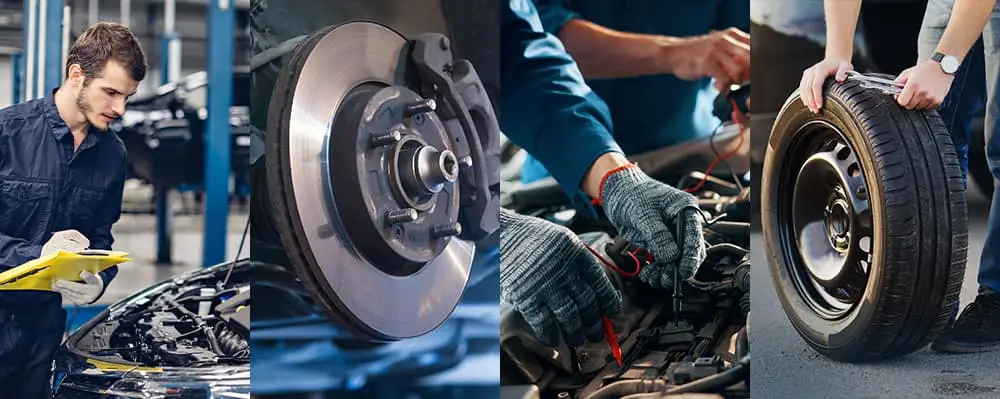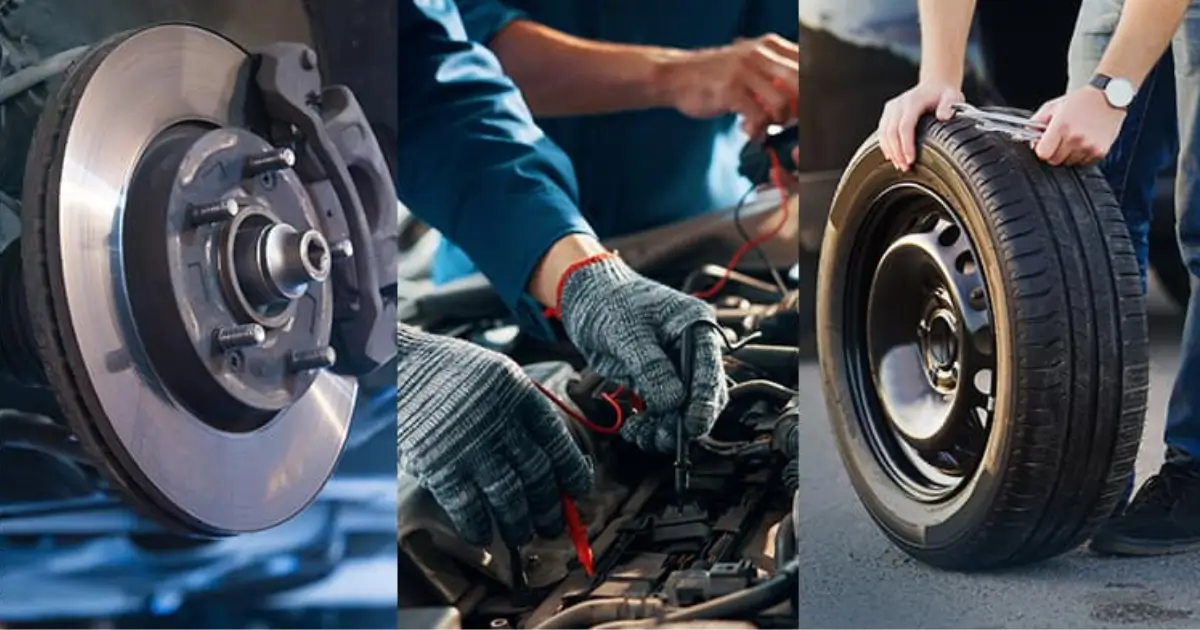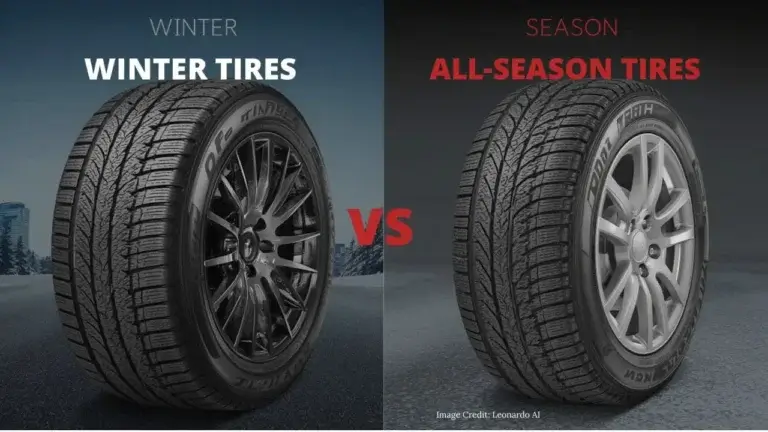The most common issue with tires is underinflation. This condition leads to uneven wear, reduced fuel efficiency, and potential tire failure.
Ensuring proper tire maintenance is crucial, as tires are the foundation of vehicle safety and performance. Regularly checking tire pressure, alignment, and tread depth can extend their lifespan and improve driving conditions. Underinflated tires generate excess heat due to increased friction, posing a risk of blowouts, especially during long journeys or at high speeds.
Drivers should adhere to the manufacturer’s recommended tire pressure and inspect their tires monthly to avoid this pervasive problem. Educating motorists about the importance of tire care helps promote road safety and optimizes vehicle operation.
By addressing tire underinflation, we can minimize accidents, decrease fuel consumption, and experience better handling and braking responses, highlighting why tire maintenance demands attention.

Credit: www.libertyhonda.com
The High Frequency Of Tire Problems
Tires are the steadfast workhorses of vehicles, constantly in contact with roads. Yet, this relentless duty leads to a common issue—frequent problems. Tires suffer from wear and tear, punctures, and pressure issues more than any other car parts. Understanding these tire issues is crucial for safe and efficient driving.
Everyday Impact On Road Safety
Tire problems lead to risky situations on roads daily. Issues such as blowouts, tread separation, or under-inflation can cause sudden accidents. Proper tire maintenance is key to preventing such events. The table below shows common tire problems and their impacts on road safety:
| Common Tire Issue | Impact on Safety |
|---|---|
| Blowouts | Can cause loss of control |
| Tread Wear | Reduces grip, increasing stopping distance |
| Under-inflation | Leads to poor handling and overheating |
| Punctures | May result in sudden deflation |
Regular check-ups and prompt repairs enhance safety for everyone on the road.
Costs And Inconveniences For Drivers
Aside from safety concerns, frequent tire issues bring costs and hassles for drivers. These range from the price of new tires to unexpected roadside assistance calls. Let’s break down these inconveniences:
- New Tires: A premium expense for drivers, especially for higher-end models.
- Repair Services: Costs for patching up or fixing tires add up over time.
- Time Lost: Unexpected tire problems can delay travel plans and commitments.
- Fuel Efficiency: Poorly maintained tires increase fuel consumption, leading to higher spending at the pump.
Maintaining tires helps avoid these unnecessary expenses and disruptions in daily life.

Credit: blog.openbay.com
Types Of Tire Issues
Tires face a range of issues, from regular wear and tear to sudden damage. Understanding these problems can help owners maintain tire safety and extend their lifespan. Let’s explore the most common tire issues that drivers encounter on the road.
Wear And Tear Patterns
Tires degrade over time, their treads wearing down with each journey. Varied wear patterns signify different issues:
- Uneven wear: Indicates alignment or suspension problems.
- Center wear: Often caused by overinflation.
- Edge wear: Underinflation may be the culprit here.
- Cupping wear: Reflects possible shocks or struts issues.
- Patchy wear: Suggests wheel balance is off-kilter.
Underinflation And Overinflation
Balanced air pressure is crucial for tire health. Underinflated tires lead to:
- Increased wear: on tire edges.
- Reduced fuel efficiency: due to extra rolling resistance.
- Overheating: causing internal tire damage.
Symptoms of overinflated tires include:
- Decreased traction: as less tire touches the road.
- Excessive wear: in the center of the tread.
- Rough ride: resulting from less shock absorption.
Punctures, Cuts, And Other Damages
Tires can suffer harm from road hazards or accidents. Common types of damages are:
- Punctures: Small holes that can lead to slow leaks.
- Cuts: Gashes that might require immediate tire replacement.
- Sidewall bulges: Weaken tire structure, increase blowout risk.
- Crack or cuts: Caused by age or exposure to elements.
- Foreign objects: Nails or glass that embed in the tire.
The Most Common Culprit: Pothole Damage
Tires face many road challenges, but one enemy lies in wait: potholes. Often undetected until it’s too late, potholes cause significant tire damage. Understanding pothole formation and its effects on tires is crucial for every driver. With informed care, drivers can minimize tire wear and extend tire life. Read on to explore the mechanics behind pothole formation and the impact on tire integrity.
Mechanics Of Pothole Formation
Potholes start small but can grow quickly. Here’s the usual process:
- Water seeps through cracks in the road.
- The water freezes and expands, widening the cracks.
- As temperatures rise, the ice melts and empty spaces form under the surface.
- Heavy vehicles drive over the weakened spot.
- The road surface collapses, and a pothole is born.
How Potholes Affect Tire Integrity
Tire damage from potholes can be immediate or gradual. Here’s what happens:
| Impact Type | Effect on Tire |
|---|---|
| Direct Hit | Bulges, tread separation, or punctures |
| Repeated Exposure | Premature wear, weakened sidewalls |
Immediate impacts can cause bent rims or even blowouts. Gradual damage includes misalignment and compromised tire structure, leading to unsafe driving conditions. Regular tire inspections help identify and address pothole-related tire problems.
Tread Wear: A Sneaky Threat
Tire issues come in various forms, but tread wear stands out as a sneaky villain. Over time, as you drive, the once deep and grooved surface of your tires flattens. This is natural, yet it can spell trouble before you notice it. Understanding tread wear and its potential risks is crucial for safe driving and long-lasting tires.
Monitoring For Uneven Wear
Uneven tread wear doesn’t happen overnight. It gradually occurs and can go unnoticed without regular checks.
- Check Tires Regularly: A simple look at each tire can save future costs.
- Use a Tread Depth Gauge: This tool tells you when to replace tires.
- Spot Patterns: Uneven wear has distinct patterns. Be alert!
Different wear patterns can hint at other car issues. A wear bar running across the tire indicates it’s time for a change.
Consequences Of Ignoring Tread Wear
Let’s not tread lightly on the results of ignoring tread wear.
| Risk | Consequence |
|---|---|
| Poor Handling | Tires lose grip, affecting steering and braking. |
| Hydroplaning | Worn treads can’t displace water, increasing skid risks. |
| Tire Blowouts | Thin treads are prone to punctures and sudden failures. |
Regular tire maintenance is not just about economy, it’s critical for safety. Ignoring wear on your tire’s tread puts everyone on the road at risk.
Challenges Of Underinflation
Tire underinflation is a common but overlooked car maintenance issue. It occurs when tires do not have enough air pressure. This can lead to many problems. One can think of a tire as a balloon. If a balloon does not have enough air, it won’t perform as expected. The same goes for tires.
Fuel Efficiency Losses
Driving on underinflated tires means your car uses more fuel. The engine must work harder to move the vehicle. It’s like trying to push a shopping cart with a stuck wheel. Imagine your car having to do this with all four wheels!
- Tires with low pressure have more contact with the road.
- It increases friction.
- Friction demands more power.
- More power means more fuel.
This bad cycle reduces miles per gallon. For a clear view, see the table below:
| Air Pressure Level | Impact on Fuel Efficiency |
|---|---|
| Correctly Inflated | Optimal Efficiency |
| Underinflated | Loss of Efficiency |
Risks To Vehicle Handling
Underinflation also compromises how cars handle. This refers to steering and braking. Think of wearing oversized shoes. It’s hard to walk. For cars, underinflated tires make turning and stopping tricky.
- They respond slowly to steering.
- Braking distances increase.
- This can lead to accidents.
Regular tire checks are important. They keep underinflation at bay. This ensures a safer drive. Always maintain recommended tire pressure.

Credit: eliteroads.com
The Impact Of Overinflation
Correct tire inflation is crucial for safe driving. Overinflation might seem like a minor issue, but it leads to several problems. Understanding the risks can save tires from damage and ensure safety on the road.
Reduced Traction on Roads
Reduced Traction On Roads
Overinflated tires cannot grip the road properly. This means more slip and less control. Especially during wet or icy conditions, this becomes riskier.
- Less surface area in contact with road
- Potential for hydroplaning increases
- Risk of accidents rises
Increased Wear on Tire Center
Increased Wear On Tire Center
Tires should wear evenly. But, overinflation causes the center to bulge and wear out first. The sides last longer than they should. The tire’s life shortens.
| Part of Tire | Wear Level |
|---|---|
| Center | High |
| Sides | Low |
Avoiding And Addressing Tire Issues
Tire issues can turn a smooth drive into a rough experience. They are common but preventable. Knowing how to avoid and address tire problems keeps you safe on the road. Let’s explore some must-know tips and signals for when to get an expert involved.
Regular Tire Maintenance Tips
Consistent care extends tire life. Follow these steps:
- Check air pressure monthly: Proper inflation prevents wear.
- Rotate your tires every 5,000 to 7,500 miles: This ensures even wear.
- Examine tires for wear and tear: Look for cuts, bulges, or irregularities.
- Balance and align periodically: It avoids uneven tread.
When To Seek Professional Help
Sometimes tire issues need a professional touch. Here’s when:
| Issue | Professional Help Needed |
|---|---|
| Constant pressure loss | Yes, get tires checked. |
| Visible sidewall damage | Yes, could risk a blowout. |
| Vibrations while driving | Yes, tires might be unbalanced. |
Vibrations, noise, or the car pulling to one side warrant a trip to the garage. If your tread wear indicators are visible, it’s time to replace your tires.
Emerging Tire Technologies
Emerging Tire Technologies play a pivotal role in enhancing vehicle safety and performance. Tires are the only point of contact between your vehicle and the road. Understanding common tire issues is crucial. Let’s explore how recent advancements are tackling these problems.
Advancements In Tire Durability
Durable tires mean fewer punctures and longer life. The industry seeks materials that resist wear and tear. Nanomaterials and advanced rubber compounds have entered the scene. They promise tougher, long-lasting treads. Key benefits of improved tire durability include:
- Reduced replacements
- Greater cost savings
- Better fuel efficiency from maintained tire integrity
Smart Tires: The Future Of Tire Monitoring
Smart tires incorporate sensors technology. These sensors report on tire health in real-time. Say goodbye to manual checks. Smart tires can alert drivers to:
- Air pressure changes
- Tread wear levels
- Potential puncture risks
This constant monitoring extends tire life. It also improves safety on the road. Smart tires represent a leap forward in tire innovation.
Conclusion
Understanding tire issues is crucial for vehicle safety and performance. Common problems often involve pressure irregularities and tread wear. Regular inspections and maintenance can prevent these issues and ensure a smoother ride. Prioritize your tires’ health to stay safe on the road and extend their lifespan.
Drive responsibly and stay vigilant for any signs of wear.




